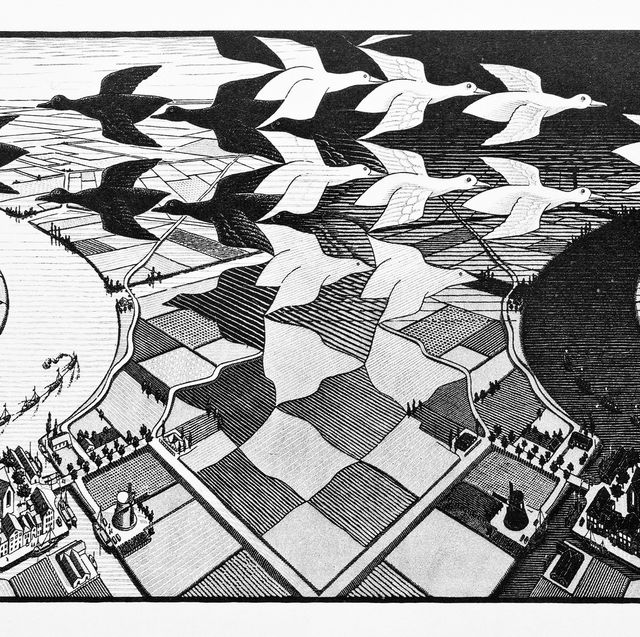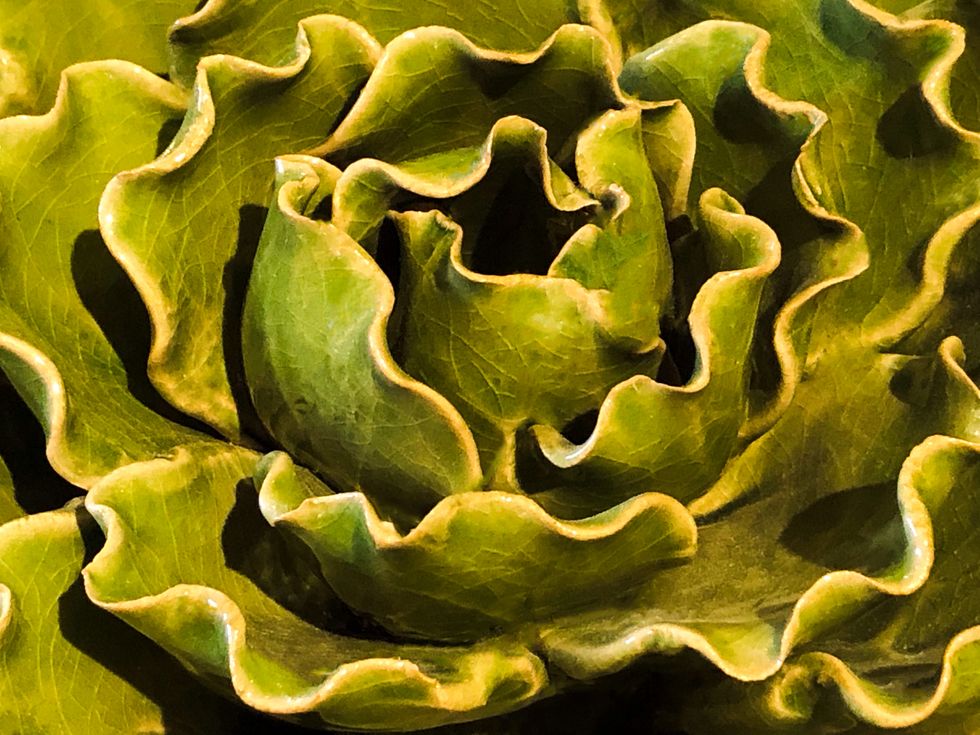- Creating mathematical artwork inspired the artist M.C. Escher to explore geometry, even though he had minimal math training.
- Representing infinity through graphic design was one of Escher’s goals.
- Escher created repeating patterns based on Spanish historical artwork, which led him to discover geometric relationships.
Math underlies many of the art pieces M.C. Escher created, because he was fascinated with the idea of depicting infinity in various ways, producing infinitely repeatable patterns known as tessellations, as well as designs that showed an infinite hyperbolic plane—a surface in which every point of the space curves away from itself—mapped onto a circle.
But his success wasn’t due to some natural affinity for math. “He had practically no training in mathematics,” Doris Schattschneider, Ph.D, a mathematics professor emerita at Moravian College, tells Popular Mechanics. “There’s no equations at all that he used. He almost failed his mathematics in high school and never went beyond high school. In fact, he didn’t actually graduate from high school. He failed his final exams.”
Escher explored geometry through tessellations, which are mosaics that fit together like puzzles and can fill an entire plane. Schattschneider says his designs featuring tessellations were inspired by his 1922 trip to the Alhambra, an Islamic historic site in Granada, Spain.
“The tilings in the Alhambra are very geometric, very abstract,” Schattschneider says. “He wanted to make tiles that were what he called ‘recognizable shapes.’ He called these motifs.”
Escher studied and sketched the geometry of the tilings in the Alhambra and tried to replicate how the tiles fit together and intersected with one another, Schattschneider says. He created animal shapes out of wood, and designed tessellations by stamping them at different angles.
The mathematical rules for these repeating patterns say that a pattern can be shifted by moving it, which is called translation. It can also be rotated or reflected; rotation involves moving around each point in a figure a certain number of degrees around a central point; reflection involves flipping the pattern over across a fixed line.
In 1936, Escher took a second trip to the Alhambra and made color pictures of the tilings, Schattschneider says. He created around a dozen tessellations that included fish, birds, and butterflies.
Escher spent around four years creating a “layman’s theory” of how shapes could fit together in a tiled pattern that could occupy a whole plane, Schattschneider explains. She described this process in the book M.C. Escher: Visions of Symmetry. His rules state that:
• every tile had to be surrounded by its copies in the same way;
• a minimum number of colors should be used; and
• no two adjacent tiles could have the same color
“He became very, very adept at producing these tilings or tessellations,” Schattschneider says. “The shapes of the motifs or the figures in them are his original imagination, but are completely constrained by the geometric rules that had to be obeyed in order for them to fit together properly. It’s rather an amazing story that he did this all on his own.”
Through corresponding with H.S.M. Coxeter, a mathematics professor at the University of Toronto, Escher received an inspiring diagram in the mail, Schattschneider says. “Inside the circle was a tessellation, if you wish, of triangles that started large in the center and then got smaller and smaller toward the edge.”
Escher became excited about this drawing because he saw this technique could be used to capture infinity in a circle. He worked to figure out the grid that underlaid the tessellation, Schattschneider says. This grid consists of intersecting circular arcs, each of which has to intersect the surrounding circle at a 90-degree angle.
Escher asked Coxeter for help with figuring out the pattern of arcs, but could not understand his answer because it was too technical. However, using Coxeter’s advice, he was able to find one more intersection point, which led him to figure out the rest, Schattschneider explains. He created three beautiful hyperbolic tessellations using what is called the Poincaré disk model.
Douglas Dunham, Ph.D., an emeritus mathematics professor from the University of Minnesota Duluth, tells Popular Mechanics that he used software to create designs that were similar to Escher’s hyperbolic disk patterns.
Escher also experimented with strange perspectives, sometimes depicting buildings from unusual angles. “He talked about, ‘Why can’t a ceiling be a floor?’” Schattschneider says.
To protect his family from living in a fascist environment in Italy, Escher left Rome, ending up in the Netherlands. This led to a change in his artistic style, Schattschneider says. He previously created images of idealized Dutch landscapes and city architecture. “In some of his later prints, he represents polyhedra, Möbius bands, knots, all these beautiful geometric forms. And he wrote very beautifully, passionately even, about the perfection of geometric form.”
“He said, ‘I can never realize what I see in my dreams,’” Schattschneider said. “No artist can ever achieve perfection.”
Kat Friedrich is a former mechanical engineer who started out as an applied math, engineering, and physics major at the University of Wisconsin-Madison. She has a graduate degree in science and environmental journalism and has edited seven news publications, two of which she co-founded. She spends her free time learning about dance and functional fitness, reading science fiction, and exploring music events.















